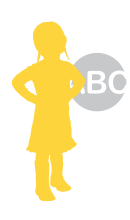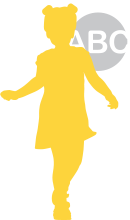Component 5: Emergent Writing
Standard 5.a: Children use a combination of drawing, dictating, and writing to show knowledge of writing conventions and demonstrate writing as a means of communication.
By the following age ranges, children typically, for example:
- Focus on people and express particular interest in facial contours and expressions
- Attend to visual stimuli in their environment

- Make marks or scribbles spontaneously on paper using a variety of media (e.g., chalk, pencil, markers, paint)

- Make intentional scribbles and shapes when offered paper and crayons or other writing instruments and show their drawings to others
- Use things the way they are intended to be used (e.g., scribbling on paper rather than on table surfaces)

- Explore a variety of writing tools
- Dictate names, labels, single words (e.g., mommy, house, dog)
- Watch when adults write
- Imitate the act of writing during play
- Describe drawings and paintings simply (e.g., “that’s Mama”)
- Use scribbles as representations of oral language (e.g., describing scribbles as writing or language by telling adult what they mean)

- Use writing tools and materials in various centers or learning environments (e.g., dramatic play, block area, science center)
- Dictate ideas, sentences, and stories
- With modeling and support, write some letters
- With modeling and support, write some numerals
- With modeling and support, discuss or answer questions about their writing and drawings
- Use letter-like symbols to create written materials during play or to express an idea
- Understand that writing carries a message and use scribbles, shapes, letter like symbols, letters, and numerals to write or represent words or ideas
- With assistance and support, engage in writing activities (e.g., labeling a picture)

- With modeling and support, use writing and/or digital tools to communicate information, tell a story, or answer a question
- Dictate longer and more complex ideas, sentences, and stories
- Write their first name nearly correctly (may switch the order of letters or write some letters backwards)
- With modeling and support, write numerals one through ten
- With modeling and support, print some letters of meaningful words, sometimes using letters and sometimes using letter-like forms
- Use writing to convey meaning (e.g., writing a note to themselves during play, writing a note to their mother, taking a restaurant “order” in a dramatic play area, writing a grocery list; writing a grocery list on a play cell-phone)
- Engage in independent writing activities during routine times, (e.g., intentionally writing in their own journal, at developmental level)
- Generate a plan for writing (e.g., articulate a purpose for writing)

